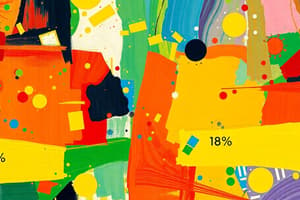Podcast
Questions and Answers
What is the main focus of microeconomics?
What is the main focus of microeconomics?
- Global economic interactions
- GDP growth rates and fiscal policies
- Unemployment rates and inflation rates
- Individual markets and consumers' behavior (correct)
Which concept in microeconomics measures how sensitive buyers' choices are to price changes?
Which concept in microeconomics measures how sensitive buyers' choices are to price changes?
- Price elasticity (correct)
- GDP growth rates
- Fiscal policy
- Production levels
What happens to prices and quantities supplied when more suppliers enter a market according to microeconomics?
What happens to prices and quantities supplied when more suppliers enter a market according to microeconomics?
- Prices fall and quantities supplied increase (correct)
- Prices rise and quantities supplied decrease
- Prices fall and quantities supplied decrease
- Prices rise and quantities supplied increase
Which area of economics explores GDP growth rates, unemployment rates, and inflation rates?
Which area of economics explores GDP growth rates, unemployment rates, and inflation rates?
What is the main goal of macroeconomics?
What is the main goal of macroeconomics?
Flashcards are hidden until you start studying
Study Notes
Economics is a broad field of study focused on how people choose to allocate resources over time. It can be broken down into two main areas of focus—microeconomics and macroeconomics. Both areas help us understand human behavior when it comes to resource allocation, but they do so from different perspectives.
Microeconomics focuses on individual markets and the behaviors of consumers and firms within them. Some key concepts in microeconomics include supply and demand, prices, costs, and production levels. For example, if there's a high demand for a product like coffee, the price for that product will rise due to supply being limited. Conversely, as more suppliers enter the market, competition increases which leads to lower prices and higher quantities supplied. This illustrates one way in which supply and demand come together to determine market equilibrium. Similarly, the concept of price elasticity also fits into this area; it shows how much quantity demanded responds to changes in price by measuring how sensitive buyers' choices are to price changes.
On the other hand, macroeconomics looks at how various parts of the economy interact with each other, including things like GDP growth rates, unemployment rates, inflation rates, and fiscal policy decisions made by government officials. One major goal here is understanding what economic conditions lead to recessions, depressions, or periods of sustained growth. Additionally, economists look at aggregate variables such as total income by state, region, etc., rather than just considering individuals or businesses. These variables allow us to make broader estimates and predictions about trends across whole industries.
In summary, economics studies how we manage our scarce resources through decision making processes. By using both microeconomic and macroeconomic principles, we develop better insights into everything from consumer preferences to societal savings patterns. Through these lenses, economics provides tools for understanding what drives changes in business cycles, employment rates, and even consumer sentiment over vast swathes of society.
Studying That Suits You
Use AI to generate personalized quizzes and flashcards to suit your learning preferences.




